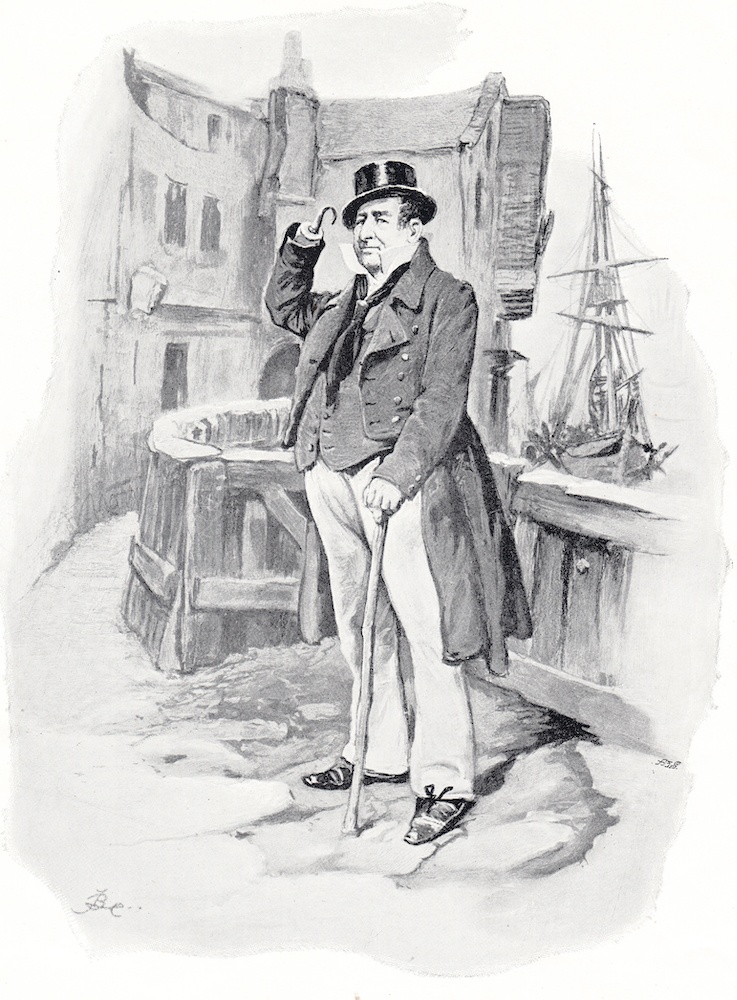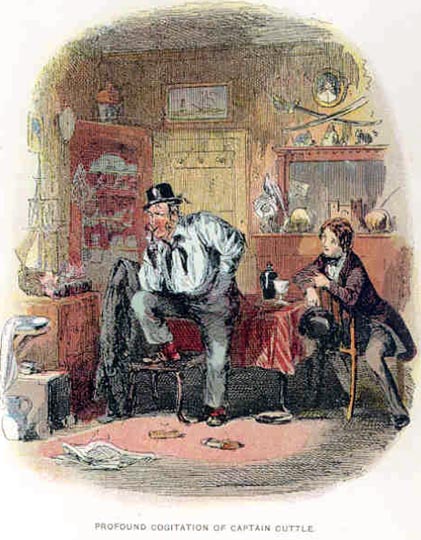

Captain Cuttle: "A gentleman in a wide suit of blue, with a hook instead of a hand attached to his right wrist; very bushy black eye-brows; and a thick stick in his left hand, covered all over (like his nose) with knobs." — Dombey and Son (1885). One of six chromolithographs in A Series of Character Sketches from Dickens, from the Original Drawings by Frederick Barnard, No. 3: Colour plate: 10 ⅜ inches high by 7 ⅜ inches wide (26.4 cm by 18.7 cm), vignetted; photogravure: 17.5 cm high by 12.7 cm wide (7 by 5 ¼ inches), vignetted. [Click on the images to enlarge them.]
Passage Realised: The Benevolent Old Salt Described
Captain Cuttle lived on the brink of a little canal near the India Docks, where there was a swivel bridge which opened now and then to let some wandering monster of a ship come roaming up the street like a stranded leviathan. The gradual change from land to water, on the approach to Captain Cuttle’s lodgings, was curious. It began with the erection of flagstaffs, as appurtenances to public-houses; then came slop-sellers’ shops, with Guernsey shirts, sou’wester hats, and canvas pantaloons, at once the tightest and the loosest of their order, hanging up outside. These were succeeded by anchor and chain-cable forges, where sledgehammers were dinging upon iron all day long. Then came rows of houses, with little vane-surmounted masts uprearing themselves from among the scarlet beans. Then, ditches. Then, pollard willows. Then, more ditches. Then, unaccountable patches of dirty water, hardly to be descried, for the ships that covered them. Then, the air was perfumed with chips; and all other trades were swallowed up in mast, oar, and block-making, and boatbuilding. Then, the ground grew marshy and unsettled. Then, there was nothing to be smelt but rum and sugar. Then, Captain Cuttle’s lodgings — at once a first floor and a top storey, in Brig Place — were close before you.
The Captain was one of those timber-looking men, suits of oak as well as hearts, whom it is almost impossible for the liveliest imagination to separate from any part of their dress, however insignificant. Accordingly, when Walter knocked at the door, and the Captain instantly poked his head out of one of his little front windows, and hailed him, with the hard glared hat already on it, and the shirt-collar like a sail, and the wide suit of blue, all standing as usual, Walter was as fully persuaded that he was always in that state, as if the Captain had been a bird and those had been his feathers. [Chapter IX, "In which the Wooden Midshipman gets into Trouble," 61 in the Household Edition]
Commentary: Captain Alfred (Ned) Cuttle, Retired Seafarer
Barnard's realistic manner of presenting the nautical veteran is not entirely consistent with his hyperbolic sea-faring demeanour and comic repartee. Dickens probably did not intend him to be anything but a kind of paste-board sailor, full of transpontine observations and quaint turns of phrase. Here, however, Barnard sees Captain Cuttle as an individual rather than a type; as we study him, he appears to be studying us. And yet every detail of the old salt at the India Docks (in the background), near his rented rooms, is present: the hard, glazed hat; the blue suit; the oversized shirt collar; and of course the hook. What Barnard imbues him with is a mature, contemplative face, in contradiction to his somewhat childlike nature in the novel.
A Captain Cuttle Gallery: Relevant Illustrations from Various Editions, 1840-1912



Left: In Phiz's December 1846 engraving, one has an excellent sense of Sol Gillis's marine store shop in this back-parlour scene between Walter, Sol, and the Captain (very much more an "old salt" here than in Barnard's 1885 study): Captain Cuttle consoles his Friend (Part 3). Centre: An anxious Walter solicits the Captain's advice in his uncle's shop in Phiz's February 1847 serial illustration: Profound Cogitation of Captain Cuttle (Part 5). Right: The Household Edition, Vol. XV, realisation of the Captain and Walter Gay, Barnard's "And you're a-going to desert your colours, are you, my lad?" said the Captain, after a long examination of his face.



Left: A much more conventional old salt with prominent hook appears in Kyd's Captain Cuttle, No. 25, in his Player's Cigarette Series "Characters from Dickens" (1912). Centre: Darley's frontispiece for the first volume of the novel in the Sheldon & Co. edition, 1862, hiding from an irate Mrs. MacStinger in Captain Cuttle in Ambush. Right: Copping's version of the old sailor has a markedly rubicund visage as he checks his watch in Captain Cuttle's Bright Idea (1924).
Related Material including Other Illustrated Editions of Dombey and Son
- Dombey and Son (homepage)
- Phiz's 40 illustrations for Dombey and Son, Wholesale Retail & for Exportation (Oct. 1846 — April 1848)
- O. C. Darley's Frontispiece in the New York edition (Vol. 1, 1862)
- O. C. Darley's Frontispiece in the New York edition (Vol. 2, 1862)
- O. C. Darley's Frontispiece in the New York edition (Vol. 3, 1862)
- Sol Eytinge, Junior's 16 Diamond Edition Illustrations (1867)
- The Illustrators of the Household Edition of the Works of Charles Dickens (22 vols., 1871-79)
- Groome's eight illustrations for the Collins Pocket Edition (1900, rpt. 1934)
- Kyd's five Player's Cigarette Cards (1910)
- Harry Furniss's 29 illustrations for the Charles Dickens Library Edition (1910)
- Harold Copping's Captain Cuttle's Bright Idea (1924).
Scanned image and text by Philip V. Allingham. [You may use this image without prior permission for any scholarly or educational purpose as long as you (1) credit the person who scanned the image, and (2) link your document to this URL in a web document or cite the Victorian Web in a print one.]
Bibliography
Barnard, Fred. Character Sketches from Dickens. (16 photogravure illustrations) London, Paris & Melbourne: Cassell, 1885.
Dickens, Charles. Dombey and Son. Illustrated by Phiz. (Hablot K. Browne). London: Chapman and Hall, 1848.
_______. Dombey and Son. Illustrated by Hablot Knight Browne (Phiz). 8 coloured plates. London and Edinburgh: Caxton and Ballantyne, Hanson, 1910.
_______. Dombey and Son. Illustrated by F. O. C. Darley and John Gilbert. The Works of Charles Dickens. The Household Edition. 55 vols. New York: Sheldon and Company, 1862. Vols. 1-4.
_______. Dombey and Son.16 Illustrations by Sol Eytinge, Jr., and A. V. S. Anthony (engraver). The Diamond Edition. Boston: Ticknor & Fields, 1867. III.
_______. Dombey and Son. Illustrated by Fred Barnard. 61 wood-engravings. The Household Edition. 22 vols. London: Chapman and Hall, 1877. XV.
_______. Dombey and Son. Illustrated by W. H. C. Groome. London and Glasgow, 1900, rpt. 1934. 2 vols. in one.
_______. Dombey and Son. Illustrated by Harry Furniss. The Charles Dickens Library Edition. 18 vols. London: Educational Book, 1910. Vol. 9.
A Series of Character Sketches from Dickens, from the Original Drawings by Frederick Barnard, Being Facsimiles of Original Drawings by Fred. Barnard. Series 3: Wilkins Micawber; Miss Betsey Trotwood; Captain Edward Cuttle; Uriah Heep; Dick Swiveller and The Marchioness; and Bob Cratchit and Tiny Tim. London: Cassell, Petter, and Galpin, 1885.
Created 10 February 2025